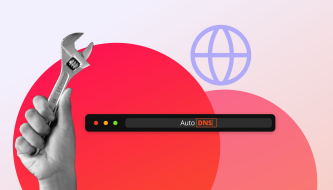
Domain investment strategies | How to get started

Expand your domain investment knowledge and take your skills to the next level. Gain the tools and strategies you need to strategically build digital assets, optimize portfolios, and thrive in the fast-paced domain market.
Published by

Simone Catania
Date
Domain names are more than just web addresses—they are digital identities and increasingly valuable investment assets. Much like real estate in the physical world, domains represent prime digital locations that offer businesses visibility, credibility, and market access. Those who invest strategically in domains today are tapping into a system based on clear rules, market dynamics, and robust technical infrastructure.
Get started with the fundamentals and gain deeper insights into domain investment strategies, key success factors, and essential tools for effective domain investing!
What is domain investment?
Domain investment refers to the strategic purchase, holding, and resale of domain names with the goal of generating profit. As with traditional investments, the aim is to benefit from value appreciation driven by factors such as market trends, branding potential, or demand. Domains can be seen as digital real estate—the better the location (i.e., the domain name), the higher the potential value.
Investors typically acquire generic meaningful terms, brandable names, or short domains that are attractive to well-known companies or high-profile projects. Premium domains, which are highly sought after due to their strong keywords, memorability, and value, often command higher prices in the market.
Another common tactic in domain investment strategies is domain parking, where revenue is generated by displaying ads on the domain’s landing page.
| Attribute | Housing investment | Domain investment |
| Initial investment | High – Requires significant capital for down payment, maintenance, and taxes. | Low – Typically requires relatively small capital to purchase domains. |
| Liquidity | Low – Selling a property can take weeks or months. | High – Domains can often be sold quickly via marketplaces or auctions. |
| Scalability | Limited – Physical resources and management constraints limit scalability. | High – Multiple domains can be acquired and managed remotely at scale. |
| Maintenance | High – Requires ongoing maintenance, property taxes, and insurance. | Low – Requires only annual renewal fees and occasional updates. |
| Risk | Medium – Affected by location, market trends, and economic shifts. | Medium – Affected by domain trends, demand, and market saturation. |
| Income potential | High – Can generate rental income or appreciation over time. | High – Can be monetized through resale, advertising, or development. |
| Market trends | Dependent on local real estate markets, zoning, and economy. | Dependent on digital market trends, popular niches, and demand. |
| Asset tangibility | Tangible – Physical property. | Intangible – Digital asset (domain name). |
| Ownership complexity | Complex – Includes legal procedures, deeds, and closing costs. | Simple – Purchase and transfer processes can often be completed online. |
| Entry barrier | High – Requires legal paperwork and compliance. | Low – Can start with minimal technical knowledge and investment. |
Domains aren’t just bought and sold—they can also be licensed or leased, creating additional revenue streams. Some investors focus on specific industries, niche topics, or language regions to leverage their expertise. Others opt for a broad portfolio to diversify opportunities and mitigate risk. Ultimately, successful domain investment strategies require a mix of market knowledge, timing, and analytical thinking, along with the ability to spot trends early.
Why does domain investment matter in 2025?
In 2025, a strong digital presence is a fundamental requirement for visibility and growth. As the internet continues to expand and more business models shift online, the market for concise, brandable, and keyword-based domain names is becoming increasingly competitive. The availability of high-quality .com domains is rapidly declining, boosting the value of already secured addresses. At the same time, new domain extensions like .xyz, .app, and .tech are gaining major traction—especially in innovation-driven industries—especially in innovation-driven industries—along with ccTLDs like .de, .fr and .at, which continue to grow in popularity for businesses targeting specific regions ccTLDs like .ai, .me and .io for their intrinsic meaning.
Domain investments play a key role in securing a clear online identity, driving search engine traffic, and building digital credibility. In an increasingly saturated digital landscape, domains are strategic assets that can strengthen market positioning. A domain’s value rises not only with demand but also with its relevance to current technologies and global trends. Looking ahead, the domain investment market is far from tapped out. In March 2023, ICANN launched the official implementation process for new top-level domains, with the next application round expected in May 2026 (pending final confirmation).
Historical milestones in domain investment
The first significant domain investment movements in the domain industry began when the internet became commercially accessible in the ‘90s, as businesses and individuals recognized the value of owning unique, brandable, and easily memorable web addresses. This marked the starting point of domains being viewed as digital real estate with immense potential for growth and resale value.
- In 1995, the company Network Solutions introduced fees for domain registrations, laying the foundation for the domain trading market.
- One of the first major domain sales occurred in 1999, when business.com was sold for approximately $7.5 million—just three years after being purchased for $150,000. Its value increased fiftyfold in that short period, highlighting the profit potential of early domain investment strategies.
- In the early 2000s, German company Sedo emerged as one of the world’s leading domain marketplaces and played a key role in professionalizing the domain industry. Over the following years, the market gained momentum. Starting around 2010, short .com domains with three or four letters experienced a boom due to their high international demand and limited availability.
- A major milestone came in 2013 with the introduction of hundreds of new gTLDs, opening up new possibilities for topic- and industry-specific domain investment strategies.
One particularly high-profile sale took place in 2019, when the domain voice.com was sold for $30 million—an impressive demonstration of the value and potential of premium digital addresses. Major brands are also increasingly investing in strategic domain acquisitions to secure their digital identity and strengthen long-term brand management. Today, domain trading has evolved into a global business, supported by specialized marketplaces, analytics tools, and a professional network of investors, brokers, and platforms.
The first steps in domain investment
Getting into domain trading doesn’t require a large amount of capital, but it does demand a clear approach and strategic thinking. The following step-by-step guide outlines how to enter the domain market and build a solid foundation for your domain investment strategies.
1Learn the basics
Start by gaining a solid understanding of how domains work, the different types of extensions, and the overall structure of the domain market. Research typical price ranges, major trading platforms, and legal considerations such as trademark rights. Building a strong foundation is key to avoiding common mistakes and developing effective domain investment strategies.
2Define your niche or strategy
Choose a thematic focus—for example, technology, finance, or short brandable terms. Alternatively, you can target generic keywords or location-based domains. Having a clear focus helps you invest with intention and efficiency.
3Research and evaluate domains
Use tools like domain appraisal services, keyword research platforms, and trend analysis tools to assess potential investments and evaluate domains correctly. Pay attention to factors such as length, relevance, marketability, and legal availability. Many investors rely on specialized portfolio tools to stay organized.
4Register or purchase domains
Domains can easily be registered through providers like InterNetX. In AutoDNS, the all-in-one platform developed by InterNetX, users get the best of both worlds by seamlessly integrating the domain market with powerful Sedo marketplace features. Don’t hesitate to negotiate—many sellers are open to offers.
5Manage and refine your portfolio
Maintain your domains regularly, monitor their market value, and stay alert to potential selling opportunities. Consider using domain parking to generate additional passive income. When needed, sell off underperforming domains to free up capital for more profitable investments.

Key skills for domain investors
Successful domain investment requires a combination of technical knowledge and essential soft skills to make the most of opportunities and minimize risks.
1Market knowledge
A deep understanding of current trends, industry developments, and the dynamics of the domain market is essential. Only those who truly know the market can spot lucrative opportunities early and respond strategically.
2Analytical thinking
Domains shouldn’t be evaluated based on name alone—they must also be assessed using criteria such as search volume, SEO potential, and branding opportunities. Strong analytical skills are essential for accurately determining a domain’s true value and making informed decisions within your domain investment strategies.
3Negotiation skills
Many domain transactions hinge on effective negotiation. A strong sense of a domain’s true value—combined with clear, persuasive communication—is key to securing favorable terms when buying or reselling.
4Basic legal knowledge
A solid understanding of trademark law, UDRP, and general legal considerations can help you avoid costly mistakes and protect your investments.
5Technical understanding
Basic knowledge of DNS, hosting, and domain management not only makes it easier to handle the technical side of things, but also supports portfolio optimization and efficient troubleshooting.
Key factors for evaluating domains as investments
For entry-level domain investors, evaluating a domain as a potential investment requires understanding several key factors.
First, domain length and memorability play a crucial role. Short, concise domains tend to be more valuable, as they are easier to remember and type.
Next, consider the domain extension (TLD), such as .com, .net, or .org. While .com is the most sought-after and widely recognized, alternative extensions may resonate with niche markets or specific industries. For example, there are many tech-related TLDs like .io, .digital, .app or .software.
Another significant factor is the presence of keywords in the domain. Domains containing high-value keywords relevant to popular industries, such as technology, finance, or health, are more likely to attract potential buyers. In addition, keywords related to current and emerging trends, such as artificial intelligence, blockchain, or cryptocurrencies, strongly influence the demand for certain domains. Domains that align with growing industries and niches tend to be in higher demand and therefore more valuable.
Furthermore, evaluate the brandability of the domain—its ability to serve as a strong, distinctive identity for businesses or projects. Premium domains, which combine strong keywords, short length, and branding potential, usually command higher value.
Additionally, research the domain’s history, as it can influence its reputation and authority in search engines. Lastly, consider the market demand for the domain’s niche and any existing development or backlinks, as these factors enhance its resale potential. By focusing on these elements, new investors can make informed decisions and identify domains with strong investment potential.
| Factor | Explanation | Tip |
| Domain length | Short domains are easier to remember and more likely to attract buyers. | Aim for domains with 1-3 words or fewer than 15 characters. |
| TLD | .com is the most recognized and sought-after, but other TLDs like .org, .net, or niche-specific extensions can also hold value. | Prioritize .com, but consider niche extensions for specific industries or trends. |
| Keywords | Domains with high-value or industry-relevant keywords attract buyers in popular markets like tech, finance, or health. | Use tools like Google Keyword Planner or our Domain Studio in AutoDNS to identify frequently searched terms. |
| Brandability | Brandable domains are unique, memorable, and easy to spell, making them ideal for businesses or startups. | Look for creative, versatile names that could be trademarks. |
| Market demand | Domains in highly competitive or growing industries often have higher resale potential. | Research trending industries and buyer preferences before purchasing. |
| Domain history | A domain’s past reputation, development, and backlinks can affect its value and search engine ranking. | Use tools like Wayback Machine or WHOIS history to review prior usage. |
| Ease of Pronunciation | Readable and easy-to-say domains tend to have higher value, as they increase brand recognition. | Avoid numbers, hyphens, or overly complicated words. |
| Resale Value (comparable sales) | Reviewing recent domain sales in similar niches can provide insights into potential returns. | Check platforms our Global Domain Report 2025, read domain blogs and check Sedo public sales. |
| Renewal and maintenance costs | Domains have annual renewal fees, which vary with extensions and registrars, as well as potential parking or appraisal costs. | Calculate your investment budget, including fees, to avoid unnecessary expenditures. |
| Domain parking revenue | Parking a domain can generate income through ad clicks while you wait to sell. | Use platforms like Sedo for domain parking and monetization options. |
Domain investment compared to other asset classes
Compared to traditional asset classes like stocks or real estate, domain investment is significantly less regulated. While this offers greater flexibility, it also requires a higher level of personal responsibility and market knowledge. Unlike real estate—which typically involves high upfront costs, long-term commitments, and complex management—domain trading allows for a relatively low entry point and flexible handling. Domains can be registered, bought, or sold entirely online, regardless of geographic location and at any time of day.
Compared to other digital investment methods like cryptocurrencies, the domain market has several unique advantages. It offers greater stability and lower volatility. While crypto assets are often subject to dramatic price swings, domain values tend to be shaped more by long-term factors such as brand relevance, search engine potential, and industry growth. Additionally, many domains offer the potential to generate passive income through domain parking.
However, domain investment requires active domain management. Selecting, evaluating, and maintaining a portfolio—along with strategically selling domains—are all essential for long-term success. Unlike broadly diversified ETFs, which can often be bought and held with minimal effort, domain investing demands continuous market monitoring and active decision-making. This hands-on approach is a core element of effective domain investment strategies.
From a tax and logistical standpoint, domains are relatively straightforward since they can be traded globally with ease. However, unlike regulated markets, the domain space lacks many of the protective mechanisms investors may be used to.
The role of premium domains in domain investment
Premium domains are highly valuable digital assets—typically short, generic, brandable, and in high demand. These domains command high prices because they combine strong visibility, SEO advantages, and brand value. For businesses, premium domains are often strategically important, as they help establish digital authority. Investors are drawn to them for their stable value and strong resale potential. Many premium domains sell for six- or even seven-figure sums at auctions. However, access to this segment usually requires substantial capital, making it especially suitable for experienced investors.
Domain investing tools powered by InterNetX
In the field of domain investment, professional tools are essential for conducting market analysis, managing domains efficiently, and streamlining sales processes. InterNetX offers powerful platforms and integrations that provide valuable support for both beginners and experienced investors.
-> Domain price check
The Domain Price Check is a data-driven valuation tool that provides accurate domain price estimates. It’s especially useful for beginners, as it helps assess the market value of domains quickly and reliably. The valuations are based on comprehensive data analysis, taking into account factors such as search volume, comparable sales, and current trends. This gives users a realistic view of what a domain may be worth—whether for purchase, resale, or portfolio evaluation.
-> AutoDNS
AutoDNS is a comprehensive platform for domain management and portfolio optimization, designed specifically for domainers. It offers an end-to-end solution that automates and streamlines all domain-related tasks—including registration, renewal, management, and sales processes. With smart technology built in, AutoDNS enables you to efficiently monitor, adjust, and optimize your portfolio at any time. A key advantage is the ability to manage your entire domain inventory in one place, perform bulk operations, and control sales listings—all from a single interface.
-> Sedo aftermarket
Sedo is one of the world’s largest and most well-known marketplaces for buying and selling domains. Sedo’s seamless integration with platforms like AutoDNS allows domain investors to market their domains efficiently and directly—without needing to switch platforms. With Sedo, you can easily list domains for sale or auction, manage offers, and reach a global audience. The platform also provides features such as instant domain appraisals, extensive promotion options, and direct access to a wide network of international buyers. This makes Sedo an essential tool for executing effective and streamlined domain investment strategies.

Maximize profits in the digital age with domain investment
Domain investment continues to offer promising opportunities for creative and strategically minded investors. With solid knowledge, the right professional tools, and a clear, well-thought-out approach, digital assets can be built and secured successfully over the long term.
The barriers to entry in the domain market are relatively low, but long-term success requires a deep understanding of market dynamics, current trends, and legal frameworks.
Those willing to think long term, closely follow market developments, and manage risks consciously can build a solid foundation for profitable investments. Domain investment strategies combine technical expertise, marketing know-how, and entrepreneurial instinct—making it a unique and rewarding asset class for forward-thinking investors.
This form of investment not only offers the potential to grow capital, but also allows investors to actively participate in digital innovation and capitalize on emerging trends early. Domain trading is an exciting field for anyone looking to combine innovation with long-term sustainability.











